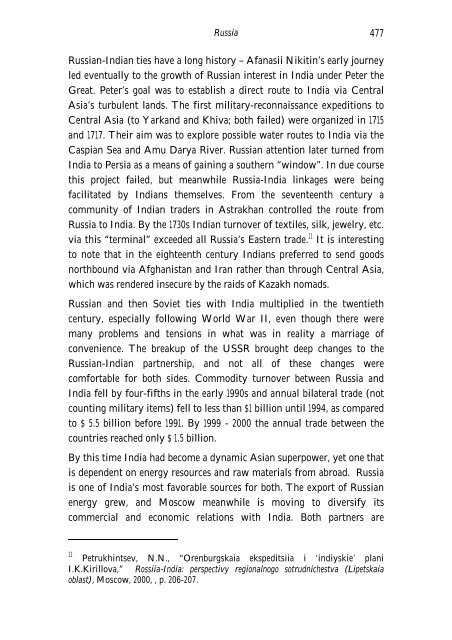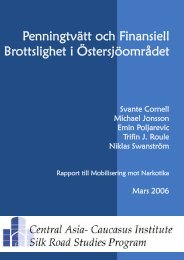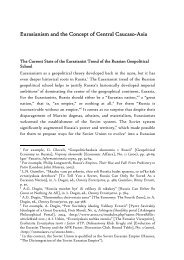Russia - Central Asia-Caucasus Institute and Silk Road Studies ...
Russia - Central Asia-Caucasus Institute and Silk Road Studies ...
Russia - Central Asia-Caucasus Institute and Silk Road Studies ...
You also want an ePaper? Increase the reach of your titles
YUMPU automatically turns print PDFs into web optimized ePapers that Google loves.
<strong>Russia</strong> 477<br />
<strong>Russia</strong>n-Indian ties have a long history – Afanasii Nikitin’s early journey<br />
led eventually to the growth of <strong>Russia</strong>n interest in India under Peter the<br />
Great. Peter’s goal was to establish a direct route to India via <strong>Central</strong><br />
<strong>Asia</strong>’s turbulent l<strong>and</strong>s. The first military-reconnaissance expeditions to<br />
<strong>Central</strong> <strong>Asia</strong> (to Yark<strong>and</strong> <strong>and</strong> Khiva; both failed) were organized in 1715<br />
<strong>and</strong> 1717. Their aim was to explore possible water routes to India via the<br />
Caspian Sea <strong>and</strong> Amu Darya River. <strong>Russia</strong>n attention later turned from<br />
India to Persia as a means of gaining a southern “window”. In due course<br />
this project failed, but meanwhile <strong>Russia</strong>-India linkages were being<br />
facilitated by Indians themselves. From the seventeenth century a<br />
community of Indian traders in Astrakhan controlled the route from<br />
<strong>Russia</strong> to India. By the 1730s Indian turnover of textiles, silk, jewelry, etc.<br />
via this “terminal” exceeded all <strong>Russia</strong>’s Eastern trade. 11 It is interesting<br />
to note that in the eighteenth century Indians preferred to send goods<br />
northbound via Afghanistan <strong>and</strong> Iran rather than through <strong>Central</strong> <strong>Asia</strong>,<br />
which was rendered insecure by the raids of Kazakh nomads.<br />
<strong>Russia</strong>n <strong>and</strong> then Soviet ties with India multiplied in the twentieth<br />
century, especially following World War II, even though there were<br />
many problems <strong>and</strong> tensions in what was in reality a marriage of<br />
convenience. The breakup of the USSR brought deep changes to the<br />
<strong>Russia</strong>n-Indian partnership, <strong>and</strong> not all of these changes were<br />
comfortable for both sides. Commodity turnover between <strong>Russia</strong> <strong>and</strong><br />
India fell by four-fifths in the early 1990s <strong>and</strong> annual bilateral trade (not<br />
counting military items) fell to less than $1 billion until 1994, as compared<br />
to $ 5.5 billion before 1991. By 1999 - 2000 the annual trade between the<br />
countries reached only $ 1.5 billion.<br />
By this time India had become a dynamic <strong>Asia</strong>n superpower, yet one that<br />
is dependent on energy resources <strong>and</strong> raw materials from abroad. <strong>Russia</strong><br />
is one of India’s most favorable sources for both. The export of <strong>Russia</strong>n<br />
energy grew, <strong>and</strong> Moscow meanwhile is moving to diversify its<br />
commercial <strong>and</strong> economic relations with India. Both partners are<br />
11 Petrukhintsev, N.N., “Orenburgskaia ekspeditsiia i ‘indiyskie’ plani<br />
I.K.Kirillova,” Rossiia-India: perspectivy regionalnogo sotrudnichestva (Lipetskaia<br />
oblast), Moscow, 2000, , p. 206-207.






